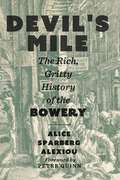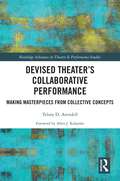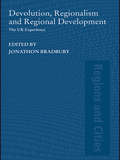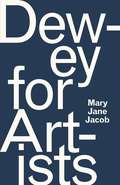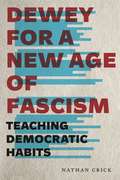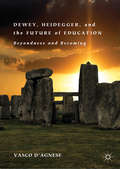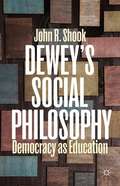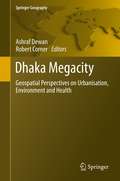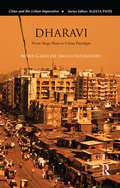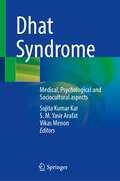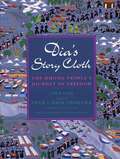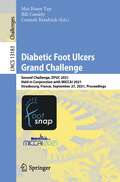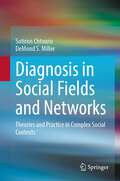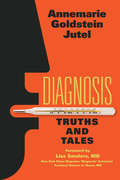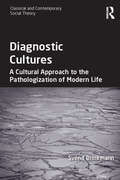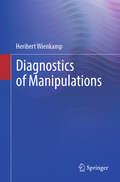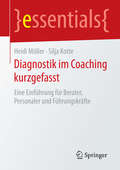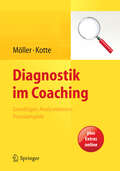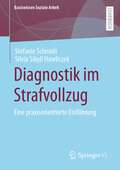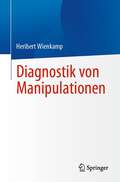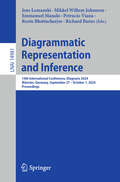- Table View
- List View
Devil's Mile: The Rich, Gritty History of the Bowery
by Alice Sparberg AlexiouDevil’s Mile tells the rip-roaring story of New York’s oldest and most unique streetThe Bowery was a synonym for despair throughout most of the 20th century. The very name evoked visuals of drunken bums passed out on the sidewalk, and New Yorkers nicknamed it “Satan’s Highway,” “The Mile of Hell,” and “The Street of Forgotten Men.” For years the little businesses along the Bowery—stationers, dry goods sellers, jewelers, hatters—periodically asked the city to change the street’s name. To have a Bowery address, they claimed, was hurting them; people did not want to venture there.But when New York exploded into real estate frenzy in the 1990s, developers discovered the Bowery. They rushed in and began tearing down. Today, Whole Foods, hipster night spots, and expensive lofts have replaced the old flophouses and dive bars, and the bad old Bowery no longer exists.In Devil’s Mile, Alice Sparberg Alexiou tells the story of the Bowery, starting with its origins, when forests covered the surrounding area, and through the pre–Civil War years, when country estates of wealthy New Yorkers lined this thoroughfare. She then describes the Bowery’s deterioration in stunning detail, starting in the post-bellum years. She ends her historical exploration of this famed street in the present, bearing witness as the old Bowery buildings, and the memories associated with them, are disappearing.
Devil's Night
by Ze'Ev ChafetsA New York Times Notable BookOn Devil's Night, the night before Halloween, some citizens of Detroit try to burn down their neighborhoods for an international audience of fire buffs. This gripping and often heartbreaking tour of the "Murder Capital of America" often seems lit by those same fires. But as a native Detroiter, Ze'ev Chafets also shows us the city beneath the crime statistics--its ecstatic storefront churches; its fearful and embittered white suburbs; its cops and criminals; and the new breed of black officials who are determined to keep Detroit running in the midst of appalling dangers and indifference.
Devised Theater’s Collaborative Performance: Making Masterpieces from Collective Concepts (Routledge Advances in Theatre & Performance Studies)
by Telory D ArendellThis book provides a fascinating and concise history of devised theatre practice. As both a founding member of Philadelphia’s Pig Iron Theater Company and a Professor, Telory Arendell begins this journey with a brief history of Joan Littlewood’s Theatre Workshop and Living Newspapers through Brecht’s Berliner Ensemble and Joe Chaikin’s Open Theatre to the racially inflected commentary of Luis Valdez’s Teatro Campesino and Ariane Mnouchkine’s collaboration with Théâtre de Soleil. This book explores the impact of devised theatre on social practice and analyzes Goat Island’s use of Pina Bausch’s gestural movement, Augusto Boal’s Theatre of the Oppressed in Giving Voice, Anna Deavere Smith’s devised envelope for Verbatim Theatre, The Tectonic Theatre Project’s moment work, Teya Sepinuck’s Theatre of Witness, Pig Iron’s use of Lecoq mime to build complex physical theatre scripts, and The Riot Group’s musical arrangement of collaborative devised text. Included are a foreword by Allen J. Kuharski and three devised plays by Theatre of Witness, Pig Iron, and The Riot Group. Replete with interviews from the initial Pig Iron collaborators on subjects of writing, directing, choreographing, teaching, and developing a pedagogical platform that supports devised theatre.
Devolution, Regionalism and Regional Development: The UK Experience (Regions and Cities)
by Jonathan BradburyDevolution, Regionalism and Regional Development provides an overview and critical perspective on the impact of devolution on regionalism in the UK since 1999, taking a research-based look at issues central to the development of regionalism: politics, governance and planning. This multidisciplinary book is written by academics from the fields of geography, economics, town planning, public policy, management, public administration, politics and sociology with a final chapter by Patrick Le Gales putting the research findings into a theoretical context. This will be an important book for those researching and studying economic and political geography and planning as well as those involved in regional development.
Devotions for a Sacred Marriage
by Gary L. ThomasThis book of fifty-two devotionals is a companion to Gary Thomas's Sacred Marriage, which enables couples to think and act upon the premise: What if God designed marriage to make us holy more than to make us happy?
Dewey for Artists
by Mary Jane JacobJohn Dewey is known as a pragmatic philosopher and progressive architect of American educational reform, but some of his most important contributions came in his thinking about art. Dewey argued that there is strong social value to be found in art, and it is artists who often most challenge our preconceived notions. Dewey for Artists shows us how Dewey advocated for an “art of democracy.” Identifying the audience as co-creator of a work of art by virtue of their experience, he made space for public participation. Moreover, he believed that societies only become—and remain—truly democratic if its citizens embrace democracy itself as a creative act, and in this he advocated for the social participation of artists. Throughout the book, Mary Jane Jacob draws on the experiences of contemporary artists who have modeled Dewey’s principles within their practices. We see how their work springs from deeply held values. We see, too, how carefully considered curatorial practice can address the manifold ways in which aesthetic experience happens and, thus, enable viewers to find greater meaning and purpose. And it is this potential of art for self and social realization, Jacob helps us understand, that further ensures Dewey’s legacy—and the culture we live in.
Dewey for a New Age of Fascism: Teaching Democratic Habits (Rhetoric and Democratic Deliberation #22)
by Nathan CrickDuring the rise of fascism in the early twentieth century, American philosopher and educational reformer John Dewey argued that the greatest threat to democracy was not a political regime or even an aggressive foreign power but rather a set of dispositions or attitudes. Though not fascist in and of themselves, these habits of thought—rugged individualism and ideological nationalism—lay the foundation for fascism. In this study, Nathan Crick uses Dewey’s social thought and philosophy of education to provide insight into and resources for transforming our present-day politics.Through a close reading of Dewey’s political writings and educational theory, Crick elaborates Dewey’s vision of democratic social life and the education required for its foundation. He shows that for Dewey, communication is essential to cultivating sympathy, intelligence, and creativity—habits of thought that form the core of democratic culture. Crick then lays out a broad curriculum of logic, aesthetics, and rhetoric for inculcating these habits in the classroom, arguing that if we are to meet the challenge of fascism, we must teach these new arts as if our civilization depends on it—because in our new age of politics, it does.Comprehensive and pragmatic, this book presents an experimental model of education that can be applied across the humanities curriculum. It will be of interest to teachers of writing, composition, and rhetoric as well as scholars and students of communication studies, pedagogy, and political theory.
Dewey for a New Age of Fascism: Teaching Democratic Habits (Rhetoric and Democratic Deliberation)
by Nathan CrickDuring the rise of fascism in the early twentieth century, American philosopher and educational reformer John Dewey argued that the greatest threat to democracy was not a political regime or even an aggressive foreign power but rather a set of dispositions or attitudes. Though not fascist in and of themselves, these habits of thought—rugged individualism and ideological nationalism—lay the foundation for fascism. In this study, Nathan Crick uses Dewey’s social thought and philosophy of education to provide insight into and resources for transforming our present-day politics.Through a close reading of Dewey’s political writings and educational theory, Crick elaborates Dewey’s vision of democratic social life and the education required for its foundation. He shows that for Dewey, communication is essential to cultivating sympathy, intelligence, and creativity—habits of thought that form the core of democratic culture. Crick then lays out a broad curriculum of logic, aesthetics, and rhetoric for inculcating these habits in the classroom, arguing that if we are to meet the challenge of fascism, we must teach these new arts as if our civilization depends on it—because in our new age of politics, it does.Comprehensive and pragmatic, this book presents an experimental model of education that can be applied across the humanities curriculum. It will be of interest to teachers of writing, composition, and rhetoric as well as scholars and students of communication studies, pedagogy, and political theory.
Dewey, Heidegger, and the Future of Education: Beyondness and Becoming
by Vasco d'AgneseDrawing on insights into the philosophies of Dewey and Heidegger, this book moves forward the greater philosophical discourse surrounding education. It illuminates deep affinities between the corresponding traditions of Dewey and Heidegger, broadly labeled hermeneutics and pragmatism, and in doing so reveals the potential of the Dewey-Heidegger comparison for the future of education. To accomplish this task, Vasco d’Agnese explores the Deweyan and Heideggerian understanding of existence and experience. Both thinkers believed that humans are vulnerable from the very beginning, delivered to an uncanny and uncertain condition. On the other hand, such an uncanniness and dependency, rather than flowing in nihilistic defeat of educational purposes, puts radical responsibility on the side of the subject. It is, then, educationally promising. The book explains that for both Dewey and Heidegger, being a subject means being-with-others while transcending and advancing one’s boundaries, thus challenging the managerial framework of education that currently dominates educational institutions throughout the world.
Dewey�s Social Philosophy
by John R. ShookDewey advanced a political vision for democracy as a form of deliberative polyarchy grounded in community ethics. This vision depicts citizens engaged in communal exercises in experimental civic education. This ethical project, to successfully pervade all of democratic society must be revolutionarily comprehensive. Maintaining the civil peace, a productive economy, a participatory citizenry, an effective penal system, and a religiously harmonious society are top democratic priorities. The economy needs employees and entrepreneurs who are more broadly educated, not merely well-trained; education is so crucial for empowerment that it must be a civic guarantee; education should be prioritized in law and criminal justice; and education is crucial for ethical communities embracing religious pluralism. Dewey's core views on humanity's capacities for learning, socializing, problem-solving, self-ruling, and flourishing forge a whole far greater than its parts. His progressive revolution is yet to be realized, but his philosophy remains just as insightful and relevant as ever.
Dhaka Megacity: Geospatial Perspectives on Urbanisation, Environment and Health
by Ashraf Dewan Robert CornerThe book Dhaka Megacity: Geospatial Perspectives on Urbanisation, Environment and Health presents the use of geospatial techniques to address a number of environmental issues, including land use change, climatic variability, urban sprawl, population density modelling, flooding, environmental health, water quality, energy resources, urban growth modelling, infectious diseases and the quality of life. Although the work is focused on the Megacity of Dhaka in Bangladesh, the techniques and methods that are used to research these issues can be utilized in any other areas where rapid population growth coupled with unplanned urbanization is leading to environmental degradation. The book is useful for people working in the area of Geospatial Science, Urban Geography, Environmental Management and International Development. Since the chapters in the book cover a range of environmental issues, this book describes useful tools for assisting informed decision making, particularly in developing countries.
Dharavi: From Mega-Slum to Urban Paradigm (Cities And The Urban Imperative Ser.)
by Marie-Caroline Saglio-YatzimirskyLocated in the heart of Mumbai, Dharavi is estimated to be the largest slum in Asia. Often referred to as ‘Little India’, it has been home to thousands of migrants from across the country providing opportunities for work and livelihood. As such, Dharavi presents a fascinating paradox: the convergence of stereotypes associated with the slum — poverty and misery — and an effervescent economic vitality, impelled by globalisation and international capital flows.Bringing together 20 years of painstaking fieldwork, this book reveals the social, economic, political, and urban complexities that define Dharavi beneath the shadow of Mumbai, the financial capital of India. It provides a rare account of the slum’s history, with a special focus on the original populace of leather workers — who form the backbone of its urban informal economy — their work, organisation and increasing political awareness. Dominated by a population of ex-‘untouchables’, conventionally stigmatised by poverty and low status, Dharavi illustrates how traditional caste-based occupational and regional divisions continue to be strong and affect structures of political governance and economy. At the same time, it testifies to an intimate encounter with consumerism, liberalisation and technological innovations, and its resultant cultural globalisation under the heady influence of media, advertising and cinema transmitted by the city of Mumbai.This book traces the mega-slum’s gradual transformation as a thriving trade centre, through an informal economy’s successful adaptation to global markets, in turn establishing an urban paradigm. It will be useful to those in sociology, anthropology, urban studies, politics, public policy and governance, and to those interested in globalisation, transnational migration and town planning.
Dhat Syndrome: Medical, Psychological and Sociocultural aspects
by S. M. Yasir Arafat Sujita Kumar Kar Vikas MenonDhat Syndrome is known as a culture-bound syndrome in South Asia. People with Dhat Syndrome often present with anxiety and distress related to semen loss. Multiple somatic and sexual symptoms often accompany this. The symptoms of Dhat Syndrome closely resemble other neurotic and stress-related disorders. Myths related to sexuality are often the core phenomenon in dhat syndrome, which is responsible for the generation of psychopathology—addressing the myth's preliminary results in resolving psychopathology. However, many patients require pharmacological and psychological management. Due to strong cultural beliefs and associated myths, patients with Dhat Syndrome often reach out to traditional healers before getting the proper psychiatric consultation, further consolidating their myths and poor attitude toward treatment. However, Dhat Syndrome resembles a male entity; a similar entity is reported in females, where females attribute their non-pathological vaginal discharge to psychological distress. The pattern of symptoms has a significant resemblance with Dhat Syndrome in males. There is no standard book that exclusively discusses various aspects of Dhat Syndrome. This book examines the evolution of Dhat Syndrome to the current understanding of the disease and its management. Hence, this book will be unique and helpful for this disorder.
Dia's Story Cloth
by Dia ChaThe story cloth made for the author by her aunt and uncle chronicles the life of the Hmong people in their native Laos and their eventual emigration to the United States.
Diabetic Foot Ulcers Grand Challenge: Second Challenge, DFUC 2021, Held in Conjunction with MICCAI 2021, Strasbourg, France, September 27, 2021, Proceedings (Lecture Notes in Computer Science #13183)
by Moi Hoon Yap Bill Cassidy Connah KendrickThis book constitutes the Second Diabetic Foot Ulcers Grand Challenge, DFUC 2021, which was held on September 27, 2021, in conjunction with the 24th International Conference on Medical Image Computing and Computer-Assisted Intervention, MICCAI 2021. The challenge took place virtually due to the COVID-19 pandemic.The 6 full papers included in this book were carefully reviewed and selected from 14 submissions. There is also an overview paper on the challenge and datasets and one summary paper of DFUC 2021.
Diagnosis Of Our Time V 3
by Karl MannheimFirst published in 1943. Routledge is an imprint of Taylor & Francis, an informa company.
Diagnosis in Social Fields and Networks: Theories and Practice in Complex Social Contexts
by DeMond S. Miller Sotirios ChtourisContaining a novel compilation of theoretical and methodological approaches, this textbook lays out the most relevant foundations of clinical sociology. Relying heavily on well-recognized medical models and concepts to help communicate ideas (e.g. treatment, diagnosis, clinical, cure), the methods of social diagnosis and social therapy presented in this book will help in better and socially informed protection of vulnerable individuals and citizens as well as an informed design of protection policies for macro, meso and micro levels of society. The book explains that many problems, perceived as economic, psychological-individual, and political, are rooted in social functions and structures of the wider society, and how these social structures and functions interact in everyday life. Through the application of the theoretical and methodological approaches in case studies on recent issues, such as the Covid pandemic, or the Hurricane Katrina disaster, the book will allow readers to easily cope with the complexity of clinical sociology and to develop clinical competencies and pertinent training. This renders the book not only highly useful for advanced undergraduate and graduate students of clinical and applied sociology but also for the preparation of courses for theoretically informed practitioners who are keen to work by defining learning objectives and learning paths.
Diagnosis: Truths and Tales
by Annemarie JutelThe announcement of a serious diagnosis is a solemn moment when directions shift, priorities change, and life appears in sharper focus. It is also a moment when a story takes shape. It is a story we are able to imagine, even if we haven’t experienced it firsthand, because the moment of diagnosis is as pervasive in popular media as it is in medicine. Diagnosis: Truths and Tales shares stories told from the perspectives of those who receive diagnoses and those who deliver them. Confronting how we address illness in our personal lives and in popular culture, this compelling book explores narratives of diagnosis while pondering the impact they have on how we experience health and disease.
Diagnostic Cultures: A Cultural Approach to the Pathologization of Modern Life (Classical and Contemporary Social Theory)
by Svend BrinkmannSome studies estimate that each year, around a quarter of the population of Western countries will suffer from at least one mental disorder. Should this be interpreted as evidence for the progress of psychiatry, a discipline that is now able to identify and treat mental illnesses that have always existed, or might it be the case that modern life somehow creates new conditions, or social pathologies? This book argues that in fact something more fundamental has been taking place in recent years: the development of diagnostic cultures. Taking account of the phenomenon of patients themselves 'pushing for' pathologization - and acknowledging therefore that this is not simply a case of psychiatry pursuing an agenda of 'medicalisation from above' - this volume examines the emerging trend towards interpreting our sufferings in terms of psychiatric conceptions and diagnostic categories. Drawing on new empirical case studies of psychological diagnoses, including depression and ADHD, and employing both cultural-psychological and sociological analyses, it charts the development of contemporary diagnostic cultures and asks whether, in transforming existential, moral and political concerns into individual psychiatric disorders, we risk losing sight of the larger historical and social forces that affect our lives. A ground-breaking examination of the shift towards the pathologization of suffering and the dangers that this presents to human self-understanding, Diagnostic Cultures will be of interest to scholars of social theory and philosophy, the sociology of culture, psychology and the sociology health and medicine.
Diagnostics of Manipulations
by Heribert WienkampManipulations are encountered "at every turn" and in countless everyday situations. If this is the case, the (early) recognition of manipulations takes absolute precedence. This is especially true for specialists regarding their diagnostics and analysis. In everything that is presented and offered in verbal expressions, the tentative differentiation between fiction and truth is the focus of the events. Because only a reasonably complete and truthful outline of the problem contains the potential for gaining insight or uncovering lies or half-truths. Lies, deceptions, excuses, etc., are manipulative activities or reactions that are intended to create a different, namely consciously false impression. However, manipulative maneuvers can be observed and require further investigation not only in interpersonal situations but also in larger social contexts or systems, for example, to successfully play games like chess or to solve problems through regulations accepted by all. This publication could particularly benefit the following target groups: executives, HR experts in academia and practice, and specialists who need to assess the credibility of statements based on "fiction and truth" or who are involved in other support mandates.
Diagnostik im Coaching kurzgefasst: Eine Einführung für Berater, Personaler und Führungskräfte (essentials)
by Heidi Möller Silja KotteDieses essential erläutert zunächst den Begriff der ,,Diagnostik" im Rahmen von Coaching und diskutiert die Notwendigkeit einer systematischen Eingangsdiagnostik. Die Autorinnen nennen die Unterschiede, die es beim diagnostischen Vorgehen im Coaching je nach theoretischer Perspektive oder ,,Coachingschule" gibt, und erörtern schulenspezifische Besonderheiten. In der Coachingdiagnostik müssen über die individuelle Ebene hinaus auch die Ebenen Rolle, Team und Organisation des Coachee berücksichtigt werden. Für diese verschiedenen Ebenen werden beispielhaft jeweils konkrete diagnostische Verfahren dargestellt. Heidi Möller und Silja Kotte stellen zudem eine Systematik zur Einordnung des diagnostischen Vorgehens im Coaching vor (Kasseler Coaching Inventar) und geben Praktikern eine Systematik für das Erstgespräch (Kasseler Coaching Raster) an die Hand.
Diagnostik im Coaching: Grundlagen, Analyseebenen, Praxisbeispiele
by Heidi Möller and Silja KotteDer Erfolg von Coaching – also der berufsbezogenen Einzelberatung von Führungskräften, Verantwortungsträgern und Selbständigen – hängt nicht nur vom Einsatz geeigneter Coaching-Tools, der Beratungskompetenz des Coaches etc. ab. – Für ein erfolgreiches Coaching ist es mindestens ebenso wichtig, zu Beginn des Prozesses die Ausgangssituation und Ziele des Klienten, seines Teams sowie der gesamten Organisation „sauber“ zu erfassen. Diagnostische Kompetenz und die Durchführung einer systematischen Diagnostik werden heute als zentrale Wirkfaktoren im Coaching benannt.Dieser Sammelband mit Beiträgen anerkannter Experten bietet erstmals eine systematische Darstellung diagnostischer Zugänge und Analyse-Ebenen im Coaching: Neben diagnostischen Ansätzen unterschiedlicher theoretischer Hintergründe (u.a. psychometrische, projektive, kreative, verhaltensorientierte) werden relevante Analyseebenen (Person, Rolle, Team, Organisation) erläutert sowie konkrete Verfahren vorgestellt. Der Band endet mit einer zusammenfassenden Systematisierung. – Wissenschaftlich fundiert und doch nah an den Anforderungen der Praxis – durch Checklisten und Fallbeispiele.Dieses Buch ist eine grundsätzliche Bereicherung für den Wissensschatz von Coaches, Beratern und Trainern: Stellen Sie Ihren Coaching-Prozess auf ein solides Fundament – entwickeln Sie Ihre diagnostische Kompetenz!
Diagnostik im Strafvollzug: Eine praxisorientierte Einführung (Basiswissen Soziale Arbeit #7)
by Stefanie Schmidt Silvia Sibyll HawliczekDas Lehrbuch ist eine praxisnahe Einführung in das Arbeitsfeld und die methodischen Herangehensweisen der Diagnostik im Strafvollzug. Es richtet sich zuvorderst an Psychologinnen und Psychologen sowie Sozialarbeiterinnen und Sozialarbeiter, die im Rahmen ihrer Tätigkeit im Justizvollzug mit diagnostischen Einschätzungen betraut sind sowie Studierende dieser Fächer. Nach einer Einführung in die Aufgaben und Rahmenbedingungen, die Diagnostik im Strafvollzug berühren, werden zwei verschiedene Modelle zur Rehabilitation straffälliger Personen (Risk-Need-Responsivity und Good Lives Model) vorgestellt, die der Diagnostik im Strafvollzug einen theoretischen Rahmen geben. Daran anknüpfend führt das Lehrbuch in unterschiedliche Methoden ein, welche den diagnostischen Urteilsprozess strukturieren. Diese Grundlagen münden schließlich in ein stärker praxisorientiertes Kapitel, in dem der Prozess der Urteilsbildung anhand zahlreicher Beispiele schrittweise vorgestellt wird.
Diagnostik von Manipulationen
by Heribert WienkampManipulationen begegnen uns auf „Schritt und Tritt“ und in unzähligen alltäglichen Situationen. Wenn dem so ist, hat das (frühzeitige) Erkennen von Manipulationen absoluten Vorrang.Dies gilt erst recht bei Fachexperten bezüglich ihrer Diagnostik und Analyse. Bei allem, was an verbalen Äußerungen aufgetischt und angeboten wird, steht die versuchsweise Differenzierung zwischen Dichtung und Wahrheit im Focus des Geschehens. Denn nur eine einigermaßen vollständige und wahrheitsgetreue Problemskizze birgt das Potenzial zur Erkenntnisgewinnung bzw. zur Entlarvung von Lügen oder Halbwahrheiten. Lügen, Täuschungen, Ausreden usw. sind manipulative Aktivitäten oder Reaktionen, die einen anderen, nämlich bewusst falschen Eindruck erzeugen sollen. Aber nicht nur in interpersonellen Situationen, sondern auch in größeren sozialen Zusammenhängen oder Systemen sind manipulative Manöver festzustellen und genauer zu erforschen, um z.B. Spiele wie das Schachspiel erfolgreich zu absolvieren oder Probleme durch von allen akzeptierte Regelungen zu lösen.Von dieser Publikation könnten als Zielgruppen besonders profitieren: Führungskräfte, Personalexperten in Wissenschaft und Praxis und Spezialisten, die entweder die Glaubwürdigkeit von Aussagen auf „Dichtung und Wahrheit“ zu beurteilen haben oder sonstigen Betreuungsmandaten nachgehen.
Diagrammatic Representation and Inference: 14th International Conference, Diagrams 2024, Münster, Germany, September 27 – October 1, 2024, Proceedings (Lecture Notes in Computer Science #14981)
by Richard Burns Emmanuel Manalo Jens Lemanski Petrucio Viana Mikkel Willum Johansen Reetu BhattacharjeeThis book constitutes the refereed proceedings of the 14th International Conference on the Theory and Application of Diagrams, Diagrams 2024, held in Münster, Germany, during September 27–October 1, 2024. The 17 full papers, 19 short papers and 11 papers of other types included in this book were carefully reviewed and selected from 69 submissions. They were organized in topical sections as follows: Keynote Talks; Analysis of Diagrams; Euler and Venn Diagrams; Diagrams in Logic; Diagrams and Applications; Diagram Tools; Historical Aspects of Diagrams; and Posters.
